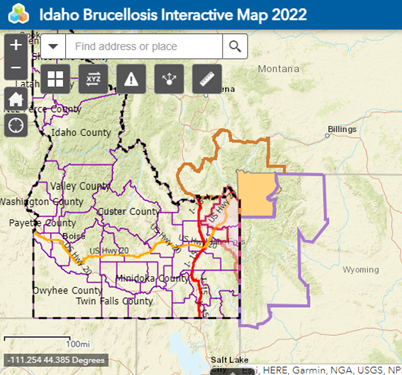Dr. Amber Itle Washington State Veterinarian
USDA declares the “win” against brucellosis, 69 years after the initiation of the U.S. Brucellosis Eradication Program. All 50 states are now considered FREE by USDA standards and the risk to cattle outside of the Greater Yellowstone Area has been deemed negligible. WOO HOO! Thank you to all the veterinarians and producers out there that have been part of getting us to this important milestone.
As with all successful programs, USDA has decided to phase out the Brucellosis Eradication Program with proposed changes in 9 CFR Part 78 — Brucellosis by the close of 2023. USDA is shifting funding and resources to other higher priority, higher risk disease response efforts. As a result, there is a national proposal to:
- remove vaccination requirement for all states without infected wildlife
- eliminate vaccination requirement in all low-risk counties in GYA states
- focus on surveillance at slaughter and movement testing strategies to replace mandatory vaccination programs
Brucellosis has evolved from being a domestic cattle disease to being a wildlife disease that only persists in bison and elk in the Greater Yellowstone Area (GYA) that includes Wyoming, Montana, and Idaho. Due to the robust herd management requirements in the GYA, early detection has confined the disease to that area, with an average of 2.6 herds detected in the GYA per year since 2010. There have been no infected dairies since 1998, and no affected beef herds outside the GYA since 2011. These successes have proven that the program based on robust testing, surveillance, and early detection has worked. USDA feels confident that the risk outside of the GYA is negligible.
Brucellosis vaccination reduces brucellosis transmission but does not prevent infection. According to the Idaho State Veterinarian, all the herds that have been positive in the Idaho GYA were vaccinated cattle. The concern is that vaccinated animals delay detection because clinical signs are masked. Most veterinarians would agree that a test-negative animal is much more reliable for disease detection. The idea here is to move away from vaccination (putting something in) and replacing that with testing (taking something out) to ensure that we are truly importing brucellosis-free animals. The only cattle that really benefit from vaccination are cattle directly exposed to infected GYA wildlife. State Veterinarians in GYA states work closely with producers to develop plans that avoid contact with wildlife by thinking through seasonality of exposure, geographic spatial mapping of the pasture and associated risks with wildlife birthing and migration patterns. Risk based vaccination requirements are under currently under consideration in GYA states.
Initially, the program relied heavily on test-and-cull programs and used vaccination to control the disease. As brucellosis prevalence dropped, the program evolved from vaccination control programs to slaughter surveillance targeting high-risk areas. Current slaughter surveillance targets the four largest plants (two in Idaho, one in California, and one in Colorado) based on catchment from GYA states. Each year, USDA is still meeting or exceeding its target of 1/100,000 prevalence with 95% confidence using Standard Operating Procedures for Submission and Testing of Brucellosis Serological Specimens (usda.gov).
WSDA proposes moving towards a voluntary brucellosis vaccination program in the next year to harmonize with other states and align our rules with federal changes. We will continue to work with veterinarians and producers on coming up with ideas for replacing the mandatory vaccination program with a mandatory identification program for breeding age animals and all cattle imported from out of state in order to maintain our robust animal disease traceability program. Please feel free to let us know your ideas for how we can best do that to meet your needs.

Idaho GYA Brucellosis Interactive Map
By Dr. Amber Itle, Washington State Veterinarian